Methane Hydrate Stability and Potential Resource in the Levant Basin, Southeastern Mediterranean Sea
Abstract
1. Introduction
1.1. Geological Setting of the Levant Basin
1.2. Natural Gas and Hydrates in the EMS
2. Materials and Methods
2.1. Hydrate Modeling Methodology
2.2. Seismic Data and Analysis Methodology
3. Results
3.1. Establishing the Local Environmental Conditions in the Deep Levant Basin
3.1.1. Bottom Water Temperature and Salinity
3.1.2. Sediment Salinity and Geothermal Gradient
3.1.3. Pressure
3.1.4. Bathymetry
3.2. Electing a GHSZ Modeling Approach for the Levant Basin
3.3. Model Sensitivities
3.3.1. Water Temperature Effects
3.3.2. Salinity Effects
3.3.3. Geothermal Effects
3.4. The Modelled Distribution of the GHSZ in the Levant Basin
3.5. Seismic Evidence for the Presence of Gas and Hydrates in the Southwestern Levant Basin
3.5.1. Pockmarks in the Southeastern Levant Basin
3.5.2. Characteristics of Seismic Reflectivity in the Southern Levant Basin
3.5.3. Vertical Distribution of the HASR
3.5.4. Spatial Distribution of the HASR
4. Discussion
4.1. The GHSZ in the Levant Basin
4.2. Methane and Hydrates in the Levant Seafloor Sediments
4.2.1. Direct Evidence for Gas Seepage at the Seafloor
4.2.2. The HASR–Evidence for Free Gas and Possibly Hydrates
4.2.3. The Shallow HASR–Evidence for Shallow Gas beneath the Levant Basin Seafloor
4.3. The Deepening HASR–a Distributed BSR in the Levant Basin (?)
4.4. The Possible Sources of Methane
4.5. Volume Assessment of Potential NGH Deposits in the Levant
5. Conclusions
- Thermodynamic modeling, using the CSMHyd software, robustly constrained by locally measured southeastern Mediterranean water temperature and salinity profiles reveals that the top of the GHSZ is at a water depth of 1250 ± 5 m. Intersecting this depth with the bathymetry reveals that more than half of the Levant Basin seafloor, namely its central to northern part, lies within the GHSZ.
- Modeling the base of the GHSZ is constrained by the lack of measured sub-seafloor thermodynamic parameters, and associated uncertainties. The primary modeling uncertainty is related with the availability and confidence of published sub-seafloor geothermal gradients. Yet, using simplistic approximations for the thermodynamic parameters yields a useful first-order approximation of the GHSZ within the Levant. The base of the GHSZ lies at a depth of 150 to 200 mbsf at a water depth of 1750 m, and may reach a depth of 430 mbsf at the northwestern edge of the studied area.
- Seafloor pockmark clusters observed in our seismic data are concentrated at a water depth of ~1200 m, just upslope from the modeled top bound of the GHSZ and mostly above the deep sea fan of the Nile. These pockmarks suggest the prominence of seafloor gas in the region, and may represent a partly ongoing gas seepage episode associated with the presumed downslope retreat of NGH since the last glacial time.
- Scattered high amplitude seismic reflectivity (HASR) is pervasively distributed beneath the seafloor across the deep sea fan of the Nile, correlating in several sites with observed active gas seepages. The HASR is therefore suggested to represent the wide spread presence of free gas, and possibly NGH, captured within buried distributed channel–levee related sandy/silty units.
- The distribution of the HASR depth beneath the seafloor vs. the water depth bifurcates into two main clusters. Most of the HASR across the study area cluster between 25 to 100 mbsf, and sub-parallel to the seafloor. This cluster is suggested to represent shallow free gas, and possibly hydrates, whose top is bounded by the SMTZ. An additional major HASR cluster trends to greater sub-seafloor depth with increasing water depth. The trend of this cluster broadly matches the modeled base of the GHSZ with a thermal gradient between 20 to 28.5 °C/km, and it is therefore suggested to represent a regionally discontinuous BSR beneath the Levant Basin. The discontinuity is attributed to the distributed nature of channel-lobes systems, into which the NGH and presumably underlying free gas are accumulated.
- Taken together, the modeling results and seismic analysis suggest the probable presence of NGH in the Levant Basin, within confined lithological bodies across the deep sea fan of the Nile. The presence of NGH is conservatively bounded between the base GHSZ modeled using the thermal gradient of 28.5 °C/km, and the SMTZ, which is estimated to occur ~25 m below the seafloor. Thus, the potential methane resource within the Levant Basin is estimated at ~100 Tcf, which would contain ~1.5 gigatonnes of carbon.
Supplementary Materials
Author Contributions
Funding
Acknowledgments
Conflicts of Interest
References
- Sloan, E.D.; Koh, C. Clathrate Hydrates of Natural Gases, 3rd ed.; CRC Press: Boca Raton, FL, USA, 2008; p. 730. [Google Scholar]
- Boswell, R.; Waite, W.F.; Kvenvolden, K.; Koh, C.A.; Klauda, J.B.; Buffett, B.A.; Frye, M.; Maslin, M. What are gas hydrates. In Frozen Heat: A UNEP Global Outlook on Methane Gas Hydrates? Beaudoin, Y.C., Waite, W., Boswell, R., Dallimore, S.R., Eds.; United Nations Environment Programme; GRID-Arendal; Birkland Trykkeri A/S: Birkeland, Norway, 2014; Volume 1, pp. 11–30. [Google Scholar]
- Kvenvolden, K.A. Methane hydrate—A major reservoir of carbon in the shallow geosphere? Chem. Geol. 1988, 71, 41–51. [Google Scholar] [CrossRef]
- Milkov, A.V. Global estimates of hydrate-bound gas in marine sediments: How much is really out there? Earth Sci. Rev. 2004, 66, 183–197. [Google Scholar] [CrossRef]
- Klauda, J.B.; Sandler, S.I. Global distribution of methane hydrate in ocean sediment. Energy Fuels 2005, 19, 459–470. [Google Scholar] [CrossRef]
- Tréhu, A.M.; Ruppel, C.; Holland, M.; Dickens, G.R.; Torres, M.E.; Collett, T.S.; Schultheiss, P. Gas hydrates in marine sediments: Lessons from scientific ocean drilling. Oceanography 2006, 19, 124–142. [Google Scholar] [CrossRef]
- Piñero, E.; Marquardt, M.; Hensen, C.; Haeckel, M.; Wallmann, K. Estimation of the global inventory of methane hydrates in marine sediments using transfer functions. Biogeosciences 2013, 10, 959–975. [Google Scholar] [CrossRef]
- Dickens, G.R.; Quinby-Hunt, M.S. Methane hydrate stability in seawater. Geophys. Res. Lett. 1994, 21, 2115–2118. [Google Scholar] [CrossRef]
- Shipley, T.H.; Houston, M.H.; Buffler, R.T.; Shaub, F.J.; McMillen, K.J.; Ladd, J.W.; Worzel, J.L. Seismic evidence for widespread possible gas hydrate horizons on continental slopes and rises. AAPG Bull. 1979, 63, 2204–2213. [Google Scholar]
- Hyndman, R.D.; Spence, G.D. A seismic study of methane hydrate marine bottom simulating reflectors. J. Geophys. Res. 1992, 97, 6683–6698. [Google Scholar] [CrossRef]
- MacKay, M.E.; Jarrard, R.D.; Westbrook, G.K.; Hyndman, R.D. Origin of bottom-simulating reflectors: Geophysical evidence from the Cascadia accretionary prism. Geology 1994, 22, 459–462. [Google Scholar] [CrossRef]
- Berndt, C.; Bünz, S.; Clayton, T.; Mienert, J.; Saunders, M. Seismic character of bottom simulating reflectors: Examples from the mid-Norwegian margin. Mar. Pet. Geol. 2004, 21, 723–733. [Google Scholar] [CrossRef]
- Shedd, W.; Boswell, R.; Frye, M.; Godfriaux, P.; Kramer, K. Occurrence and nature of “bottom simulating reflectors” in the northern Gulf of Mexico. Mar. Pet. Geol. 2012, 34, 31–40. [Google Scholar] [CrossRef]
- Majumdar, U.; Cook, A.E.; Shedd, W.; Frye, M. The connection between natural gas hydrate and bottom-simulating reflectors. Geophys. Res. Lett. 2016, 43, 7044–7051. [Google Scholar] [CrossRef]
- Tsuji, Y.; Fujii, T.; Hayashi, M.; Kitamura, R.; Nakamizu, M.; Ohbi, K.; Saeki, T.; Yamamoto, K.; Namikawa, T.; Inamori, T.; et al. Methane-hydrate occurrence and distribution in the eastern Nankai Trough, Japan: Findings of the Tokai-oki to Kumano-nada methane-hydrate drilling program. In Natural Gas Hydrates—Energy Resource Potential and Associated Geologic Hazards; Collett, T., Johnson, A., Knapp, C., Boswell, R., Eds.; AAPG Memoir; American Association of Petroleum Geologists: Tulsa, OK, USA, 2009; Volume 89, pp. 228–246. [Google Scholar]
- Kvenvolden, K.A. Methane hydrate in the global organic carbon cycle. Terra Nova 2002, 14, 302–306. [Google Scholar] [CrossRef]
- Dickens, G.R. Rethinking the global carbon cycle with a large, dynamic and microbially mediated gas hydrate capacitor. Earth Planet. Sci. Lett. 2003, 213, 169–183. [Google Scholar] [CrossRef]
- Beaudoin, Y.C.; Waite, W.; Boswell, R.; Dallimore, S.R. (Eds.) Frozen Heat: A UNEP Global Outlook on Methane Gas Hydrates; United Nations Environment Programme, GRID-Arendal; Birkland Trykkeri A/S: Birkeland, Norway, 2014; Volume 2, p. 96. [Google Scholar]
- Dickens, G.R. Carbon cycle: The blast in the past. Nature 1999, 401, 752–755. [Google Scholar] [CrossRef]
- Kennett, J.P.; Cannariato, K.G.; Hendy, I.L.; Behl, R.J. Carbon isotopic evidence for methane hydrate instability during Quaternary interstadials. Science 2000, 288, 128–133. [Google Scholar] [CrossRef] [PubMed]
- Buffett, B.; Archer, D. Global inventory of methane clathrate: Sensitivity to changes in the deep ocean. Earth Planet. Sci. Lett. 2004, 227, 185–199. [Google Scholar] [CrossRef]
- Wallmann, K.; Dallimore, S.; Biastoch, A.; Westrook, G.; Shakova, N.; Severinghaus, J.; Dickens, G.; Mienert, J. Assessment of the sensitivity and response of Methane hydrate to global climatic change. In Frozen Heat: A UNEP Global Outlook on Methane Gas Hydrates; Beaudoin, Y.C., Waite, W., Boswell, R., Dallimore, S.R., Eds.; United Nations Environment Programme, GRID-Arendal; Birkland Trykkeri A/S: Birkeland, Norway, 2014; Volume 1, pp. 50–75. [Google Scholar]
- Sultan, N.; Cochonat, P.; Foucher, J.P.; Mienert, J. Effect of gas hydrates melting on seafloor slope instability. Mar. Geol. 2004, 213, 379–401. [Google Scholar] [CrossRef]
- McConnell, D.R.; Zhang, Z.; Boswell, R. Review of progress in evaluating gas hydrate drilling hazards. Mar. Pet. Geol. 2012, 34, 209–223. [Google Scholar] [CrossRef]
- Hecht, A. Abrupt changes in the characteristics of Atlantic and Levantine intermediate waters in the Southeastern Levantine Basin. Oceanol. Acta 1992, 15, 25–42. [Google Scholar]
- Lejeusne, C.; Chevaldonné, P.; Pergent-Martini, C.; Boudouresque, C.F.; Pérez, T. Climate change effects on a miniature ocean: The highly diverse, highly impacted Mediterranean Sea. Trends Ecol. Evol. 2010, 25, 250–260. [Google Scholar] [CrossRef] [PubMed]
- Sisma-ventura, G.; Yam, R.; Kress, N.; Shemesh, A. Water column distribution of stable isotopes and carbonate properties in the South-eastern Levantine basin (Eastern Mediterranean): Vertical and temporal change. J. Mar. Syst. 2016, 158, 13–25. [Google Scholar] [CrossRef]
- Miles, P.R. Potential distribution of methane hydrate beneath the European continental margins. Geophys. Res. Lett. 1995, 22, 3179–3182. [Google Scholar] [CrossRef]
- Praeg, D.; Geletti, R.; Wardell, N.; Unnithan, V.; Mascle, J.; Migeon, S.; Camerlenghi, A. The Mediterranean Sea: A natural laboratory to study gas hydrate dynamics. In Proceedings of the 7th International Conference on Gas Hydrates (ICGH 2011), Edinburgh, UK, 17–21 July 2011; pp. 17–21. [Google Scholar]
- Klauda, J.B.; Sandler, S.I. Phase behavior of clathrate hydrates: A model for single and multiple gas component hydrates. Chem. Eng. Sci. 2003, 58, 27–42. [Google Scholar] [CrossRef]
- Merey, S.; Longinos, N. Does the Mediterranean Sea have potential for producing gas hydrates? J. Nat. Gas Sci. Eng. 2018, 55, 113–134. [Google Scholar] [CrossRef]
- Fylaktos, N.; Papanicolas, C.N. New technologies for Eastern Mediterranean offshore gas exploration. In European Parliamentary Research Service; Scientific Foresight Unit (STOA): Brussels, Belgium, 2019; PE 634.419; p. 68. [Google Scholar]
- Minshull, A.M.; Marín-Moreno, H.; Betlem, P.; Bialas, J.; Buenz, S.; Burwicz, E.; Cameselle, A.L.; Cifci, G.; Giustiniani, M.; Hillman, J.I.T.; et al. Hydrate occurrence in Europe: A review of available evidence. Mar. Pet. Geol. in review.
- Garfunkel, Z. Constrains on the origin and history of the Eastern Mediterranean basin. Tectonophysics 1998, 298, 5–35. [Google Scholar] [CrossRef]
- Robertson, A.H.F. Mesozoic-Tertiary tectonic evolution of the easternmost Mediterranean area: Integration of marine and land evidence. In Proceedings of the Ocean Drilling Program, Scientific Results; Robertson, A.H.F., Emeis, K.C., Richter, C., Camerlenghi, A., Eds.; ODP: College Station, TX, USA, 1998; Volume 160, Chapter 54; pp. 723–782. [Google Scholar]
- Aksu, A.E.; Hall, J.; Yaltırak, C. Miocene–recent evolution of Anaximander Mountains and Finike Basin at the junction of Hellenic and Cyprus arcs, eastern Mediterranean. Mar. Geol. 2009, 258, 24–47. [Google Scholar] [CrossRef]
- Briand, F. (Ed.) The Messinian Salinity Crisis from mega-deposits to microbiology—A consensus report. In N° 33 in CIESM Workshop Monographs; CIESM: Monaco, 2008; p. 168. [Google Scholar]
- Meilijson, A.; Hilgen, F.; Sepúlveda, J.; Steinberg, J.; Fairbank, V.; Flecker, R.; Waldmann, N.D.; Spaulding, S.A.; Bialik, O.M.; Boudinot, F.G.; et al. Chronology with a pinch of salt: Integrated stratigraphy of Messinian evaporites in the deep Eastern Mediterranean reveals long-lasting halite deposition during Atlantic connectivity. Earth Sci. Rev. 2019, 194, 374–398. [Google Scholar] [CrossRef]
- Madof, A.S.; Bertoni, C.; Lofi, J. Discovery of vast fluvial deposits provides evidence for drawdown during the late Miocene Messinian salinity crisis. Geology 2019, 47, 171–174. [Google Scholar] [CrossRef]
- Gardosh, M.; Druckman, Y.; Buchbinder, B.; Rybakov, M. The Levant Basin Offshore Israel: Stratigraphy, Structure, Tectonic Evolution and Implications for Hydrocarbon Exploration; Geophysical Institute of Israel Report 429/218/06; Geophysical Institute of Israel: Lod, Israel, 2006; p. 118. [Google Scholar]
- Steinberg, J.; Gvirtzman, Z.; Folkman, Y.; Garfunkel, Z. Origin and nature of the rapid late Tertiary filling of the Levant Basin. Geology 2011, 39, 355–358. [Google Scholar] [CrossRef]
- Ryan, W.B. Messinian badlands on the southeastern margin of the Mediterranean Sea. Mar. Geol. 1978, 27, 349–363. [Google Scholar] [CrossRef]
- Gvirtzman, Z.; Reshef, M.; Buch-Leviatan, O.; Groves-Gidney, G.; Karcz, Z.; Makovsky, Y.; Ben-Avraham, Z. Bathymetry of the Levant basin: Interaction of salt-tectonics and surficial mass movements. Mar. Geol. 2015, 360, 25–39. [Google Scholar] [CrossRef]
- Macgregor, D.S. The development of the Nile drainage system: Integration of onshore and offshore evidence. Pet. Geosci. 2012, 18, 417–431. [Google Scholar] [CrossRef]
- Sestini, G. Nile Delta: A review of depositional environments and geological history. In Deltas; Sites and Traps for Fossil Fuels; Whateley, M.K.G., Pickering, K.T., Eds.; Geological Society of London: London, UK, 1989; pp. 99–127. [Google Scholar]
- Folkman, Y.; Mart, Y. Newly recognized eastern extension of the Nile deep-sea fan. Geology 2008, 36, 939–942. [Google Scholar] [CrossRef]
- Clark, I.R.; Cartwright, J.A. Interactions between submarine channel systems and deformation in deepwater fold belts: Examples from the Levant Basin, Eastern Mediterranean Sea. Mar. Pet. Geol. 2009, 26, 1465–1482. [Google Scholar] [CrossRef]
- Tibor, G.; Ben-Avraham, Z.; Steckler, M.; Fligelman, H. Late Tertiary subsidence history of the Southern Levant Margin, Eastern Mediterranean Sea, and its implications to the understanding of the Messinian event. J. Geophys. Res. 1992, 97, 17593–17614. [Google Scholar] [CrossRef]
- Buchbinder, B.; Zilberman, E. Sequence stratigraphy of Miocene-Pliocene carbonate-siliciclastic shelf deposits in the eastern Mediterranean margin (Israel): Effects of eustasy and tectonics. Sediment. Geol. 1997, 112, 7–32. [Google Scholar] [CrossRef]
- Schattner, U.; Lazar, M. Hierarchy of source-to-sink systems—Example from the Nile distribution across the eastern Mediterranean. Sediment. Geol. 2016, 343, 119–131. [Google Scholar] [CrossRef]
- Almogi-Labin, A.; Bar-Matthews, M.; Shriki, D.; Kolosovsky, E.; Paterne, M.; Schilman, B.; Matthews, A. Climatic variability during the last 90ka of the southern and northern Levantine Basin as evident from marine records and speleothems. Quat. Sci. Rev. 2009, 28, 2882–2896. [Google Scholar] [CrossRef]
- Castañeda, I.S.; Schefuß, E.; Pätzold, J.; Damsté, J.S.S.; Weldeab, S.; Schouten, S. Millennial-scale sea surface temperature changes in the eastern Mediterranean (Nile River Delta region) over the last 27,000 years. Paleoceanography 2010, 25, PA1208. [Google Scholar] [CrossRef]
- Ehrmann, W.; Schmiedl, G.; Seidel, M.; Krüger, S.; Schulz, H. A distal 140 kyr sediment record of Nile discharge and East African monsoon variability. Clim. Past 2016, 12, 713–727. [Google Scholar] [CrossRef]
- Emeis, K.C.; Sakamoto, T.; Wehausen, R.; Brumsack, H.J. The sapropel record of the eastern Mediterranean Sea—Results of Ocean Drilling Program Leg 160. Palaeogeogr. Palaeoclimatol. Palaeoecol. 2000, 158, 371–395. [Google Scholar] [CrossRef]
- Rohling, E.J.; Marino, G.; Grant, K.M. Mediterranean climate and oceanography, and the periodic development of anoxic events (sapropels). Earth Sci. Rev. 2015, 143, 62–97. [Google Scholar] [CrossRef]
- Calvert, S.E.; Fontugne, M.R. On the late Pleistocene-Holocene sapropel record of climatic and oceanographic variability in the eastern Mediterranean. Paleoceanogr. Paleoclimatol. 2001, 16, 78–94. [Google Scholar] [CrossRef]
- Tachikawa, K.; Vidal, L.A.; Cornuault, M.; Garcia, M.; Pothin, A.; Sonzogni, C.; Bard, E.; Menot, G.; Revel, M. Eastern Mediterranean Sea circulation inferred from the conditions of S1 sapropel deposition. Clim. Past 2015, 11, 855–867. [Google Scholar] [CrossRef]
- Calvert, S.E.; Nielsen, B.; Fontugne, M.R. Evidence from nitrogen isotope ratios for enhanced productivity during formation of eastern Mediterranean sapropels. Nature 1992, 359, 223–225. [Google Scholar] [CrossRef]
- De Lange, G.J.; Brumsack, H. Pore-water indications for the occurrence of gas hydrates in Eastern Mediterranean mud dome structures. In Proceedings of the Ocean Drilling Program, Scientific Results; Robertson, A.H.F., Emeis, K.C., Richter, C., Camerlenghi, A., Eds.; ODP: College Station, TX, USA, 1998; Volume 160, pp. 569–574. [Google Scholar]
- Ducassou, E.; Migeon, S.; Mulder, T.; Murat, A.; Capotondi, L.; Bernasconi, S.M.; Mascle, J. Evolution of the Nile deep-sea turbidite system during the Late Quaternary: Influence of climate change on fan sedimentation. Sedimentology 2009, 56, 2061–2090. [Google Scholar] [CrossRef]
- Long, D.; Lovell, M.A.; Rees, J.G.; Rochelle, C.A. (Eds.) Sediment-Hosted Gas Hydrates: New Insights on Natural and Synthetic Systems. Geol. Soc. Lond. Spec. Publ. 2009, 319, 1–9. [Google Scholar] [CrossRef]
- Hall, J.K.; Udintsev, G.B.; Odinikov, Y.Y. Geologic Structure of the Northeastern MEDITERRANEAN (Cruise 5 of the Research Vessel Akademik Nikolay Strakhov); Historical Productions-Hall Ltd.: Jerusalem, Israel, 1994; pp. 5–32. [Google Scholar]
- Lykousis, V.; Alexandri, S.; Woodside, J.; De Lange, G.; Dählmann, A.; Perissoratis, C.; Rousakis, G. Mud volcanoes and gas hydrates in the Anaximander mountains (Eastern Mediterranean Sea). Mar. Pet. Geol. 2009, 26, 854–872. [Google Scholar] [CrossRef]
- Perissoratis, C.; Ioakim, C.; Alexandri, S.; Woodside, J.; Nomikou, P.; Dählmann, A.; Lykousis, V. Thessaloniki mud volcano, the shallowest gas hydrate-bearing mud volcano in the Anaximander Mountains, Eastern Mediterranean. J. Geol. Res. 2011, 2011, 247983. [Google Scholar] [CrossRef]
- Römer, M.; Sahling, H.; Pape, T.; dos Santos Ferreira, C.; Wenzhöfer, F.; Boetius, A.; Bohrmann, G. Methane fluxes and carbonate deposits at a cold seep area of the Central Nile Deep Sea Fan, Eastern Mediterranean Sea. Mar. Geol. 2014, 347, 27–42. [Google Scholar] [CrossRef]
- Loncke, L.; Mascle, J. Mud volcanoes, gas chimneys, pockmarks and mounds in the Nile deep-sea fan (Eastern Mediterranean): Geophysical evidences. Mar. Pet. Geol. 2004, 21, 669–689. [Google Scholar] [CrossRef]
- Dupré, S.; Woodside, J.; Foucher, J.P.; De Lange, G.; Mascle, J.; Boetius, A.; Harmégnies, F. Seafloor geological studies above active gas chimneys off Egypt (Central Nile Deep Sea Fan). Deep Sea Res. Part I Oceanogr. Res. Pap. 2007, 54, 1146–1172. [Google Scholar] [CrossRef]
- Coleman, D.F.; Ballard, R.D. A highly concentrated region of cold hydrocarbon seeps in the Southeastern Mediterranean Sea. Geo-Mar. Lett. 2001, 21, 162–167. [Google Scholar] [CrossRef]
- Coleman, D.F.; Austin, J.A., Jr.; Ben-Avraham, Z.; Makovsky, Y.; Tchernov, D. Seafloor pockmarks, deepwater corals, and cold seeps along the continental margin of Israel. Oceanography 2012, 25, 41–44. [Google Scholar]
- Rubin-Blum, M.; Antler, G.; Turchyn, A.V.; Tsadok, R.; Goodman-Tchernov, B.N.; Shemesh, E.; Tchernov, D. Hydrocarbon-related microbial processes in the deep sediments of the Eastern Mediterranean Levantine Basin. FEMS Microbiol. Ecol. 2014, 87, 780–796. [Google Scholar] [CrossRef] [PubMed]
- Makovsky, Y.; Rüggeberg, A.; Bialik, O.; Foubert, A.; Almogi-Labin, A.; Alter, Y.; Bampas, V.; Basso, D.; Feenstra, E.; Fentimen, R.; et al. R/V AEGAEO Cruise EUROFLEETS2 SEMSEEP 20.09.–01.10.2016, Piraeus (Greece)–Piraeus (Greece); EUROFLEETS2 Cruise Summary Report; Université de Fribourg: Fribourg, Switzerland, 2016; p. 62. [Google Scholar]
- Mayer, L.; Bell, K.L.C.; Ballard, R.; Nicolaides, S.; Konnaris, K.; Hall, J.; Shank, T.M. Discovery of sinkholes and seeps on Eratosthenes Seamount. Oceanography 2011, 24, 28–29. [Google Scholar]
- Mitchell, G.; Mayer, L.; Bell, L.C.; Ballard, R.D.; Raineault, N.A.; Roman, C.; Ballard, W.B.A.; Cornwell, K.; Hine, A.; Shinn, E.; et al. Exploration of Eratosthenes Seamount—A continental fragment being forced down an oceanic trench. Oceanography 2013, 26, 36–41. [Google Scholar]
- Praeg, D.; Geletti, R.; Mascle, J.; Unnithan, V.; Harmegnies, F. Geophysical exploration for gas hydrates in the Mediterranean Sea and a bottom-simulating reflection on the Nile Fan. In Proceedings of the 2008 GNGTS, Trieste, Italy, 6–8 October 2008; pp. 467–469. [Google Scholar]
- Sharaf El Din, S.; Nassar, M. Gas hydrates over the Egyptian Med. Coastal waters. In Proceedings of the 2010 EGU General Assembly Conference Abstracts, Vienna, Austria, 2–7 May 2010; Volume 12, p. 78. [Google Scholar]
- Praeg, D.; Migeon, S.; Mascle, J.; Unnithan, V.; Wardell, N.; Geletti, R.; Ketzer, J.M. Geophysical evidence of gas hydrates associated with widespread gas venting on the central Nile Deep-Sea Fan, offshore Egypt. In Proceedings of the 9th International Conference on Gas Hydrates, Denver, CO, USA, 25–30 June 2017. [Google Scholar]
- Dimitrov, L.; Woodside, J. Deep sea pockmark environments in the eastern Mediterranean. Mar. Geol. 2003, 195, 263–276. [Google Scholar] [CrossRef]
- Bertoni, C.; Kirkham, C.; Cartwright, J.; Hodgson, N.; Rodriguez, K. Seismic indicators of focused fluid flow and cross-evaporitic seepage in the Eastern Mediterranean. Mar. Pet. Geol. 2017, 88, 472–488. [Google Scholar] [CrossRef]
- Bertoni, C.; Cartwright, J.A. 3D seismic analysis of circular evaporite dissolution structures, Eastern Mediterranean. J. Geol. Soc. 2005, 162, 909–926. [Google Scholar] [CrossRef]
- Lazar, M.; Schattner, U.; Reshef, M. The great escape: An intra-Messinian gas system in the eastern Mediterranean. Geophys. Res. Lett. 2012, 39, L20309. [Google Scholar] [CrossRef]
- Bertoni, C.; Cartwright, J.; Hermanrud, C. Evidence for large-scale methane venting due to rapid drawdown of sea level during the Messinian Salinity Crisis. Geology 2013, 41, 371–374. [Google Scholar] [CrossRef]
- Eruteya, O.E.; Waldmann, N.; Schalev, D.; Makovsky, Y.; Ben-Avraham, Z. Intra-to post-Messinian deep-water gas piping in the Levant Basin, SE Mediterranean. Mar. Pet. Geol. 2015, 66, 246–261. [Google Scholar] [CrossRef]
- Cartwright, J.; Kirkham, C.; Bertoni, C.; Hodgson, N.; Rodriguez, K. Direct calibration of salt sheet kinematics during gravity-driven deformation. Geology 2018, 46, 623–626. [Google Scholar] [CrossRef]
- Ezra, O. Topology and Formation Settings of Deep Water Carbonates at the Boundaries of the Palmahim Disturbance, Offshore Israel. Master’s Thesis, The Moses Strauss Department of Marine Geosciences, University of Haifa, Haifa, Israel, 2017. [Google Scholar]
- Garfunkel, Z. Large-scale submarine rotational slumps and growth faults in the eastern Mediterranean. Mar. Geol. 1984, 55, 305–324. [Google Scholar] [CrossRef]
- Gardosh, M.A.; Tannenbaum, E. The petroleum systems of Israel. In Petroleum Systems of the Tethyan Region; Marlow, L., Kendall, C., Yose, L., Eds.; AAPG Memoir; American Association of Petroleum Geologists: Tulsa, OK, USA, 2014; Volume 106, pp. 179–216. [Google Scholar]
- Esestime, P.; Hewitt, A.; Hodgson, N. Zohr—A newborn carbonate play in the Levantine Basin, East-Mediterranean. First Break 2016, 34, 87–93. [Google Scholar]
- Bayon, G.; Loncke, L.; Dupré, S.; Caprais, J.C.; Ducassou, E.; Duperron, S.; Etoubleau, J.; Foucher, J.P.; Fouquet, Y.; Gontharet, S.; et al. Multi-disciplinary investigation of fluid seepage on an unstable margin: The case of the Central Nile deep sea fan. Mar. Geol. 2009, 261, 92–104. [Google Scholar] [CrossRef]
- Colorado School of Mines Center for Hydrate Research Web Site. Available online: http://hydrates.mines.edu/CHR/Software.html (accessed on 2 December 2012).
- PERSEUS Web Site. Available online: http://isramar.ocean.org.il/Perseus_data/CastMap.aspx (accessed on 17 March 2013).
- Robinson, A.R.; Malanotte-Rizzoli, P.; Hecht, A.; Michelato, A.; Roether, W.; Theocharis, A.; Bishop, J.; POEM Group. General circulation of the Eastern Mediterranean. Earth Sci. Rev. 1992, 32, 285–309. [Google Scholar] [CrossRef]
- Zavatarielli, M.; Mellor, G.L. A numerical study of the Mediterranean Sea circulation. J. Phys. Oceanogr. 1995, 25, 1384–1414. [Google Scholar] [CrossRef]
- Kress, N.; Manca, B.B.; Klein, B.; Deponte, D. Continuing influence of the changed thermohaline circulation in the eastern Mediterranean on the distribution of dissolved oxygen and nutrients: Physical and chemical characterization of the water masses. J. Geophys. Res. Oceans 2003, 108, 8109. [Google Scholar] [CrossRef]
- Erickson, A.J. The Measurements and Interpretation of Heat Flow in the Mediterranean and Black Sea. Ph.D. Thesis, Massachusetts Institute of Technology, Cambridge, MA, USA, 1970. [Google Scholar]
- Levitte, D.; Greitzer, Y. Geothermal update report from Israel 2005. In World Geothermal Congress 2005; International Geothermal Association: Auckland, New Zealand, 2005; pp. 1–5. [Google Scholar]
- Riad, S.; Abdelrahman, E.M.; Refai, E.; El-Ghalban, H.M. Geothermal studies in the Nile Delta, Egypt. J. Afr. Earth Sci. (Middle East) 1989, 9, 637–649. [Google Scholar] [CrossRef]
- Eppelbaum, L.; Modelevsky Jr, M.; Pilchin, A. Geothermal investigations in the Dead Sea Rift zone, Israel: Implications for petroleum geology. J. Pet. Geol. 1996, 19, 425–444. [Google Scholar] [CrossRef]
- Marlow, L.; Kornpihl, K.; Kendall, C.G. 2-D basin modeling study of petroleum systems in the Levantine Basin, Eastern Mediterranean. GeoArabia 2011, 16, 17–42. [Google Scholar]
- Ruppel, C.; Dickens, G.R.; Castellini, D.G.; Gilhooly, W.; Lizarralde, D. Heat and salt inhibition of gas hydrate formation in the northern Gulf of Mexico. Geophys. Res. Lett. 2005, 32. [Google Scholar] [CrossRef]
- Portnov, A.; Cook, A.E.; Heidari, M.; Sawyer, D.E.; Santra, M.; Nikolinakou, M. Salt-driven evolution of a gas hydrate reservoir in Green Canyon, Gulf of Mexico. AAPG Bull. 2019. [Google Scholar] [CrossRef]
- Boswell, R.; Collett, T.S.; Frye, M.; Shedd, W.; McConnell, D.R.; Shelander, D. Subsurface gas hydrates in the northern Gulf of Mexico. Mar. Pet. Geol. 2012, 34, 4–30. [Google Scholar] [CrossRef]
- Mann, D.M.; Mackenzie, A.S. Prediction of pore fluid pressures in sedimentary basins. Mar. Pet. Geol. 1990, 7, 55–65. [Google Scholar] [CrossRef]
- Judd, A.; Hovland, M. Seabed Fluid Flow: The Impact on Geology, Biology and the Marine Environment; Cambridge University Press: New York, NY, USA, 2009; p. 475. [Google Scholar]
- Kvenvolden, K.A. Natural gas hydrate: Background and history of discovery. In Natural Gas Hydrate in Oceanic and Permafrost Environments; Max, M.D., Ed.; Springer: Dordrecht, The Netherlands, 2000; pp. 9–16. [Google Scholar]
- Bjørlykke, K.; Høeg, K.; Mondol, N.H. Introduction to Geomechanics: Stress and strain in sedimentary basins. In Petroleum Geoscience from Sedimentary Environments to Rock Physics; Bjørlykke, K., Ed.; Springer: Berlin/Heidelberg, Germany, 2015; pp. 301–318. [Google Scholar]
- Ridout-Jamieson, R.H. Geological Well Summary Hannah-1, Samedan Mediterranean Sea; Cambrian Consultants Ltd.: New York, NY, USA, 2003; p. 30. [Google Scholar]
- Leroy, C.C.; Parthiot, F. Depth-pressure relationships in the oceans and seas. J. Acoust. Soc. Am. 1998, 103, 1346–1352. [Google Scholar] [CrossRef]
- Hall, J.K.; Lippman, S.; Gardosh, M.; Tibor, G.; Sade, A.R.; Sade, H.; Golan, A.; Amit, G.; Gur-Arie, L.; Nissim, I. A New Bathymetric Map for the Israeli EEZ: Preliminary Results; Ministry of National Infrastructures, Energy and Water Resources and the Survey of Israel: Jerusalem, Israel, 2015; p. 11. [Google Scholar]
- Brown, K.M.; Bangs, N.L.; Froelich, P.N.; Kvenvolden, K.A. The nature, distribution, and origin of gas hydrate in the Chile Triple Junction region. Earth Planet. Sci. Lett. 1996, 139, 471–483. [Google Scholar] [CrossRef]
- Sloan, E.D. Clathrate Hydrates of Natural Gases, 2nd ed.; CRC Press: New York, NY, USA, 1998. [Google Scholar]
- Mienert, J.; Vanneste, M.; Bünz, S.; Andreassen, K.; Haflidason, H.; Sejrup, H.P. Ocean warming and gas hydrate stability on the mid-Norwegian margin at the Storegga Slide. Mar. Pet. Geol. 2005, 22, 233–244. [Google Scholar] [CrossRef]
- Camps, A.P.; Long, D.; Rochelle, C.A.; Lovell, M.A. Mapping hydrate stability zones offshore Scotland. Spec. Publ. Geol. Soc. Lond. 2009, 1, 81–91. [Google Scholar] [CrossRef]
- Duan, Z.; Li, D.; Chen, Y.; Sun, R. The influence of temperature, pressure, salinity and capillary force on the formation of methane hydrate. Geosci. Front. 2011, 2, 125–135. [Google Scholar] [CrossRef]
- Milkov, A.V.; Dickens, G.R.; Claypool, G.E.; Lee, Y.J.; Borowski, W.S.; Torres, M.E.; Schultheiss, P. Co-existence of gas hydrate, free gas, and brine within the regional gas hydrate stability zone at Hydrate Ridge (Oregon margin): Evidence from prolonged degassing of a pressurized core. Earth Planet. Sci. Lett. 2004, 222, 829–843. [Google Scholar] [CrossRef]
- Wang, S.; Wen, Y.; Song, H. Mapping the thickness of the gas hydrate stability zone in the South China Sea. TAO Terr. Atmos. Ocean. Sci. 2006, 17, 815–828. [Google Scholar] [CrossRef]
- Liu, X.; Flemings, P.B. Passing gas through the hydrate stability zone at southern Hydrate Ridge, offshore Oregon. Earth Planet. Sci. Lett. 2006, 241, 211–226. [Google Scholar] [CrossRef]
- Macelloni, L.; Simonetti, A.; Knapp, J.H.; Knapp, C.C.; Lutken, C.B.; Lapham, L.L. Multiple resolution seismic imaging of a shallow hydrocarbon plumbing system, Woolsey Mound, Northern Gulf of Mexico. Mar. Pet. Geol. 2012, 38, 128–142. [Google Scholar] [CrossRef]
- Somoza, L.; León, R.; Medialdea, T.; Pérez, L.F.; González, F.J.; Maldonado, A. Seafloor mounds, craters and depressions linked to seismic chimneys breaching fossilized diagenetic bottom simulating reflectors in the central and southern Scotia Sea, Antarctica. Glob. Planet. Chang. 2014, 123, 359–373. [Google Scholar] [CrossRef]
- Plaza-Faverola, A.; Vadakkepuliyambatta, S.; Hong, W.L.; Mienert, J.; Bünz, S.; Chand, S.; Greinert, J. Bottom-simulating reflector dynamics at Arctic thermogenic gas provinces: An example from Vestnesa Ridge, offshore west Svalbard. J. Geophys. Res. Solid Earth 2017, 122, 4089–4105. [Google Scholar] [CrossRef]
- Sun, R.; Duan, Z. An accurate model to predict the thermodynamic stability of methane hydrate and methane solubility in marine environments. Chem. Geol. 2007, 244, 248–262. [Google Scholar] [CrossRef]
- Yang, D.; Xu, W. Effects of salinity on methane gas hydrate system. Sci. China Ser. D Earth Sci. 2007, 50, 1733–1745. [Google Scholar] [CrossRef]
- Frey-Martinez, J.F.; Cartwright, J.; Hall, B. 3D seismic interpretation of slump complexes: Examples from the continental margin of Israel. Basin Res. 2005, 17, 83–108. [Google Scholar] [CrossRef]
- Xu, W.; Ruppel, C. Predicting the occurrence, distribution, and evolution of methane gas hydrate in porous marine sediments. J. Geophys. Res. Solid Earth 1999, 104, 5081–5095. [Google Scholar] [CrossRef]
- Henry, P.; Thomas, M.; Clennell, M.B. Formation of natural gas hydrates in marine sediments: 2. Thermodynamic calculations of stability conditions in porous sediments. J. Geophys. Res. 1999, 104, 23005–230022. [Google Scholar] [CrossRef]
- Dillon, W.P.; Lee, M.W. Gas Hydrates on the Atlantic Continental Margin of the United States—Controls on Concentration. US Geol. Surv. Prof. Pap. 1993, 1570, 313–330. [Google Scholar]
- Vergnaud-Grazzini, C.; Devaux, M.; Znaidi, J. Stable isotope “anomalies” in Mediterranean Pleistocene records. Mar. Micropaleontol. 1986, 10, 35–69. [Google Scholar] [CrossRef]
- Fleming, K.; Johnston, P.; Zwartz, D.; Yokoyama, Y.; Lambeck, K.; Chappell, J. Refining the eustatic sea-level curve since the Last Glacial Maximum using far-and intermediate-field sites. Earth Planet. Sci. Lett. 1998, 163, 327–342. [Google Scholar] [CrossRef]
- Sultan, N.; Voisset, M.; Marsset, T.; Vernant, A.M.; Cauquil, E.; Colliat, J.L.; Curinier, V. Detection of free gas and gas hydrate based on 3D seismic data and cone penetration testing: An example from the Nigerian Continental Slope. Mar. Geol. 2007, 240, 235–255. [Google Scholar] [CrossRef]
- Sha, Z.; Liang, J.; Zhang, G.; Yang, S.; Lu, J.; Zhang, Z.; Humphrey, G. A seepage gas hydrate system in northern South China Sea: Seismic and well log interpretations. Mar. Geol. 2015, 366, 69–78. [Google Scholar] [CrossRef]
- Zhang, Z.; McConnell, D.R.; Han, D.H. Rock physics-based seismic trace analysis of unconsolidated sediments containing gas hydrate and free gas in Green Canyon 955, Northern Gulf of Mexico. Mar. Pet. Geol. 2012, 34, 119–133. [Google Scholar] [CrossRef]
- Wever, T.F.; Abegg, F.; Fiedler, H.M.; Fechner, G.; Stender, I.H. Shallow gas in the muddy sediments of Eckernförde Bay, Germany. Cont. Shelf Res. 1998, 18, 1715–1739. [Google Scholar] [CrossRef]
- Tréhu, A.M.; Long, P.E.; Torres, M.E.; Bohrmann, G.R.R.F.; Rack, F.R.; Collett, T.S.; Goldberg, D.S.; Milkov, A.V.; Riedel, M.; Schultheiss, P.; et al. Three-dimensional distribution of gas hydrate beneath southern Hydrate Ridge: Constraints from ODP Leg 204. Earth Planet. Sci. Lett. 2004, 222, 845–862. [Google Scholar] [CrossRef]
- Collett, T.S.; Johnson, A.H.; Knapp, C.C.; Boswell, R. (Eds.) Natural Gas Hydrates: A Review. In Natural gas Hydrates-Energy Resource Potential and Associated Geologic Hazards; AAPG Memoir; American Association of Petroleum Geologists: Tulsa, OK, USA, 2009; Volume 89, pp. 146–219. [Google Scholar]
- Peltzer, E.T.; Brewer, P.G. Practical physical chemistry and empirical predictions of methane hydrate stability. In Natural Gas Hydrate in Oceanic and Permafrost Environments; Max, M.D., Ed.; Springer: Dordrecht, The Netherlands, 2000; pp. 17–28. [Google Scholar]
- Crutchley, G.J.; Pecher, I.A.; Gorman, A.R.; Henrys, S.A.; Greinert, J. Seismic imaging of gas conduits beneath seafloor seep sites in a shallow marine gas hydrate province, Hikurangi Margin, New Zealand. Mar. Geol. 2010, 272, 114–126. [Google Scholar] [CrossRef]
- Gorman, A.R.; Holbrook, W.S.; Hornbach, M.J.; Hackwith, K.L.; Lizarralde, D.; Pecher, I. Migration of methane gas through the hydrate stability zone in a low-flux hydrate province. Geology 2002, 30, 327–330. [Google Scholar] [CrossRef]
- Regnier, P.; Dale, A.W.; Arndt, S.; LaRowe, D.E.; Mogollón, J.; Van Cappellen, P. Quantitative analysis of anaerobic oxidation of methane (AOM) in marine sediments: A modeling perspective. Earth Sci. Rev. 2011, 106, 105–130. [Google Scholar] [CrossRef]
- Dale, A.W.; Regnier, P.; Van Cappellen, P.; Fossing, H.; Jensen, J.B.; Jørgensen, B.B. Remote quantification of methane fluxes in gassy marine sediments through seismic survey. Geology 2009, 37, 235–238. [Google Scholar] [CrossRef]
- Tishchenko, P.; Hensen, C.; Wallmann, K.; Wong, C.S. Calculation of the stability and solubility of methane hydrate in seawater. Chem. Geol. 2005, 219, 37–52. [Google Scholar] [CrossRef]
- Duan, Z.; Mao, S.A. thermodynamic model for calculating methane solubility, density and gas phase composition of methane-bearing aqueous fluids from 273 to 523 K and from 1 to 2000 bar. Geochim. Cosmochim. Acta 2006, 70, 3369–3386. [Google Scholar] [CrossRef]
- Borowski, W.S.; Paull, C.K.; Ussler, W. Marine pore-water sulfate profiles indicate in situ methane flux from underlying gas hydrate. Geology 1996, 24, 655–658. [Google Scholar] [CrossRef]
- Niewöhner, C.; Hensen, C.; Kasten, S.; Zabel, M.; Schulz, H.D. Deep sulfate reduction completely mediated by anaerobic methane oxidation in sediments of the upwelling area off Namibia. Geochim. Cosmochim. Acta 1998, 62, 455–464. [Google Scholar] [CrossRef]
- Borowski, W.S.; Paull, C.K.; Ussler, W. Global and local variations of interstitial sulfate gradients in deep-water, continental margin sediments: Sensitivity to underlying methane and gas hydrates. Mar. Geol. 1999, 159, 131–154. [Google Scholar] [CrossRef]
- Dickens, G.R. Sulfate profiles and barium fronts in sediment on the Blake Ridge: Present and past methane fluxes through a large as hydrate reservoir. Geochim. Cosmochim. Acta 2001, 65, 529–543. [Google Scholar] [CrossRef]
- Treude, T. Anaerobic Oxidation of Methane in Marine Sediments. Ph.D. Thesis, University of Bremen, Bremen, Germany, 2003. [Google Scholar]
- Coffin, R.; Pohlman, J.; Gardner, J.; Downer, R.; Wood, W.; Hamdan, L.; Diaz, J. Methane hydrate exploration on the mid Chilean coast: A geochemical and geophysical survey. J. Pet. Sci. Eng. 2007, 56, 32–41. [Google Scholar] [CrossRef]
- Coffin, R.; Hamdan, L.; Plummer, R.; Smith, J.; Gardner, J.; Hagen, R.; Wood, W. Analysis of methane and sulfate flux in methane-charged sediments from the Mississippi Canyon, Gulf of Mexico. Mar. Pet. Geol. 2008, 25, 977–987. [Google Scholar] [CrossRef]
- Abreu, V.; Sullivan, M.; Pirmez, C.; Mohrig, D. Lateral accretion packages (LAPs): An important reservoir element in deep water sinuous channels. Mar. Pet. Geol. 2003, 20, 631–648. [Google Scholar] [CrossRef]
- Gay, A.; Lopez, M.; Cochonat, P.; Séranne, M.; Levaché, D.; Sermondadaz, G. Isolated seafloor pockmarks linked to BSRs, fluid chimneys, polygonal faults and stacked Oligocene–Miocene turbiditic palaeochannels in the Lower Congo Basin. Mar. Geol. 2006, 226, 25–40. [Google Scholar] [CrossRef]
- Ramana, M.V.; Ramprasad, T.; Paropkari, A.L.; Borole, D.V.; Rao, B.R.; Karisiddaiah, S.M.; Desa, M.; Kocherla, M.; Joao, H.M.; Lokabharati, P.; et al. Multidisciplinary investigations exploring indicators of gas hydrate occurrence in the Krishna–Godavari Basin offshore, east coast of India. Geo-Mar. Lett. 2009, 29, 25–38. [Google Scholar] [CrossRef]
- Riedel, M.; Collett, T.S.; Shankar, U. Documenting channel features associated with gas hydrates in the Krishna–Godavari Basin, offshore India. Mar. Geol. 2011, 279, 1–11. [Google Scholar] [CrossRef]
- Claypool, G.E.; Kaplan, I.R. The origin and distribution of methane in marine sediments. In Natural Gases in Marine Sediments; Kaplan, I.R., Ed.; Plenum Press: New York, NY, USA, 1974; pp. 99–139. [Google Scholar]
- Paull, C.K.; Ussler, W.; Borowski, W.S. Sources of biogenic methane to form marine gas hydrates. In situ production or upward migration? Ann. N. Y. Acad. Sci. 1994, 715, 392–409. [Google Scholar] [CrossRef]
- Malinverno, A. Marine gas hydrates in thin sand layers that soak up microbial methane. Earth Planet. Sci. Lett. 2010, 292, 399–408. [Google Scholar] [CrossRef]
- Davie, M.K.; Buffett, B.A. Sources of methane for marine gas hydrate: Inferences from a comparison of observations and numerical models. Earth Planet. Sci. Lett. 2003, 206, 51–63. [Google Scholar] [CrossRef]
- Haacke, R.R.; Westbrook, G.K.; Hyndman, R.D. Gas hydrate, fluid flow and free gas: Formation of the bottom-simulating reflector. Earth Planet. Sci. Lett. 2007, 261, 407–420. [Google Scholar] [CrossRef]
- Kroon, D.; Alexander, I.; Little, M.; Lourens, L.J.; Matthewson, A.; Robertson, A.H.; Sakamoto, T. Oxygen isotope and sapropel stratigraphy in the eastern Mediterranean during the last 3.2 million years. In Proceedings of the Ocean Drilling Program, Scientific Results; Robertson, A.H.F., Emeis, K.-C., Richter, C., Camerlenghi, A., Eds.; ODP: College Station, TX, USA, 1998; Volume 160, Chapter 14; pp. 181–189. [Google Scholar]
- Cramp, A.; O’Sullivan, G. Neogene sapropels in the Mediterranean: A review. Mar. Geol. 1999, 153, 11–28. [Google Scholar] [CrossRef]
- Bar-Matthews, M.; Ayalon, A.; Kaufman, A. Timing and hydrological conditions of Sapropel events in the Eastern Mediterranean, as evident from speleothems, Soreq cave, Israel. Chem. Geol. 2000, 169, 145–156. [Google Scholar] [CrossRef]
- Eckstein, Y. Review of heat flow data from the eastern Mediterranean region. Pure Appl. Geophys. 1978, 117, 150–159. [Google Scholar] [CrossRef]
- Makris, J.; Stobbe, C. Physical properties and state of the crust and upper mantle of the Eastern Mediterranean Sea deduced from geophysical data. Mar. Geol. 1984, 55, 347–363. [Google Scholar] [CrossRef]
- Camerlenghi, A.; Cita, M.B.; Vedova, B.D.; Fusi, N.; Mirabile, L.; Pellis, G. Geophysical evidence of mud diapirism on the Mediterranean Ridge accretionary complex. Mar. Geophys. Res. 1995, 17, 115–141. [Google Scholar] [CrossRef]
- Wallmann, K.; Pinero, E.; Burwicz, E.; Haeckel, M.; Hensen, C.; Dale, A.; Ruepke, L. The global inventory of methane hydrate in marine sediments: A theoretical approach. Energies 2012, 5, 2449–2498. [Google Scholar] [CrossRef]
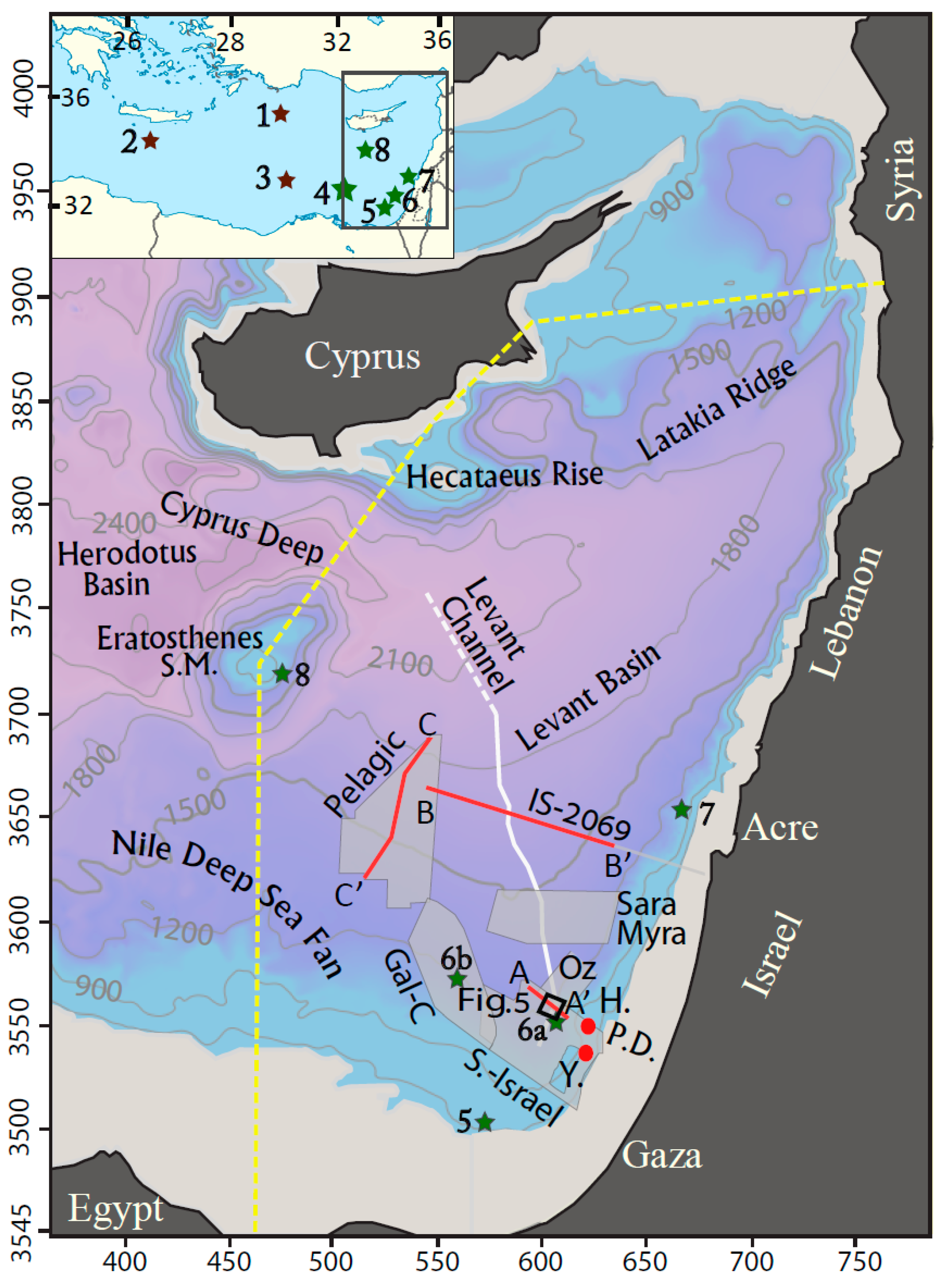
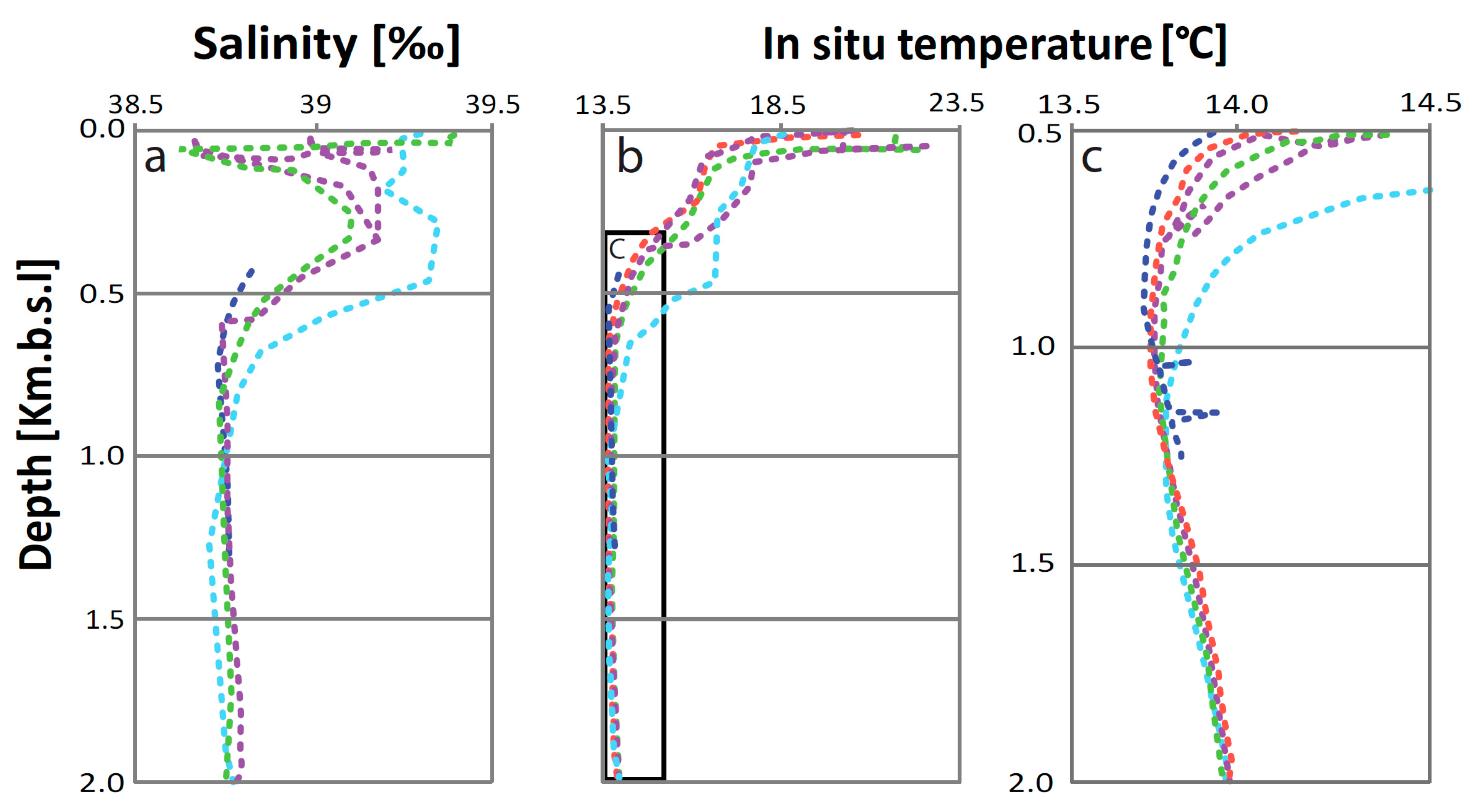
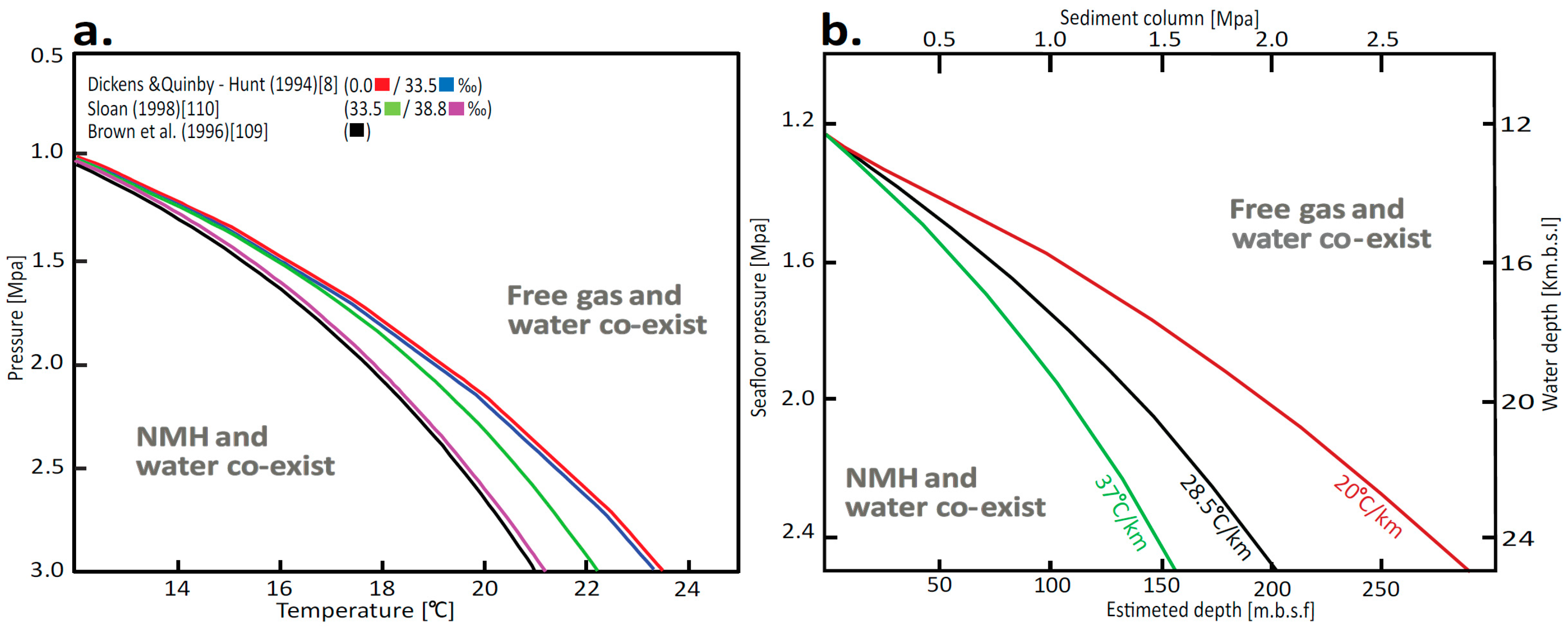
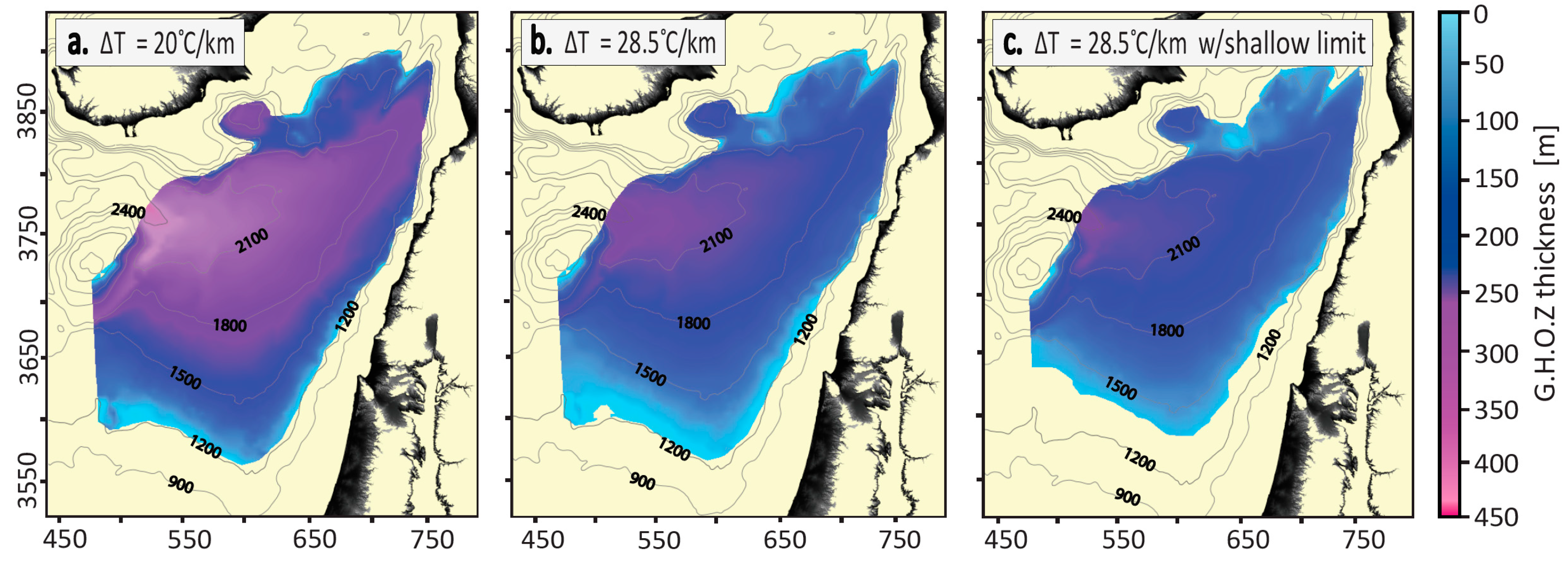
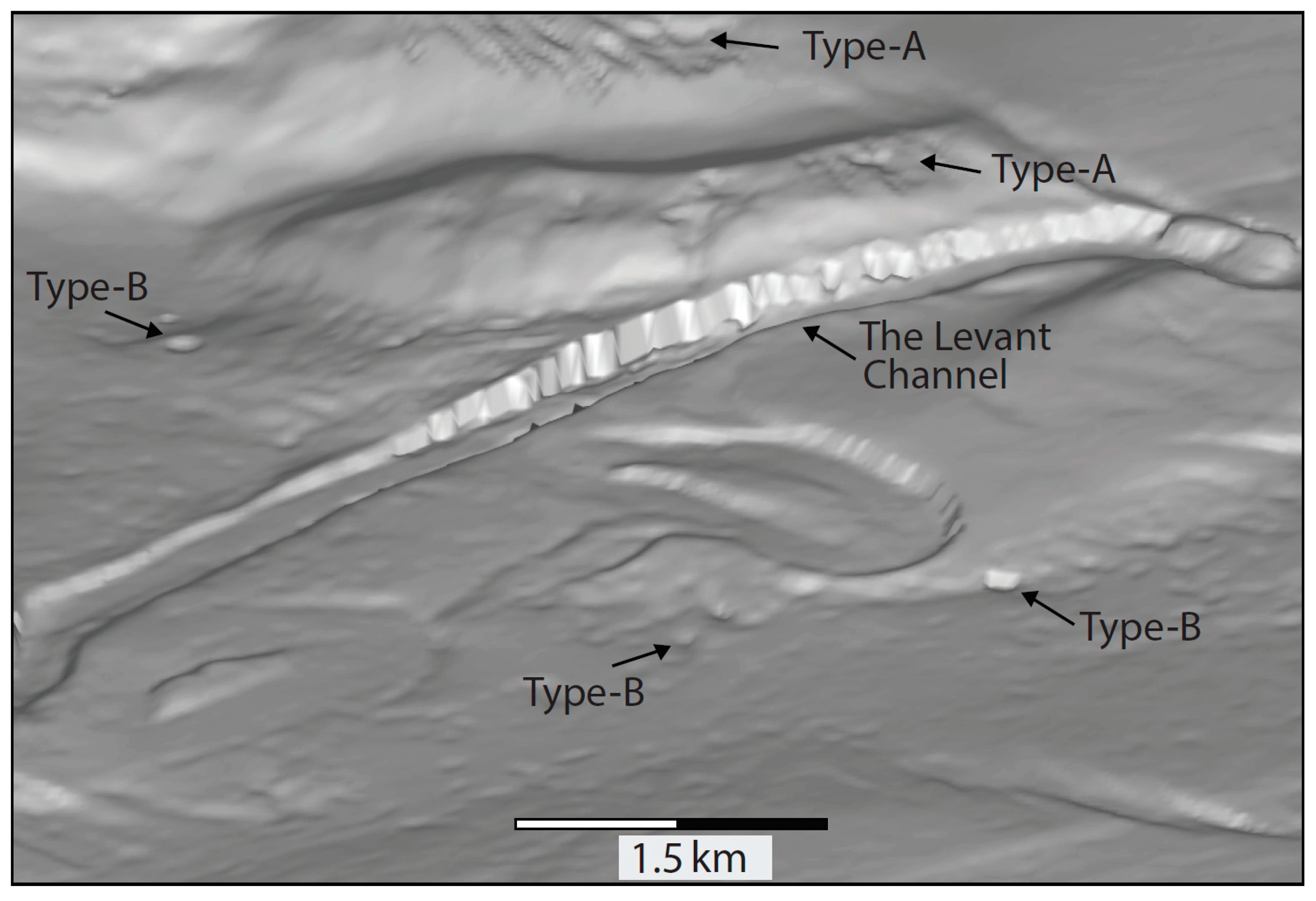
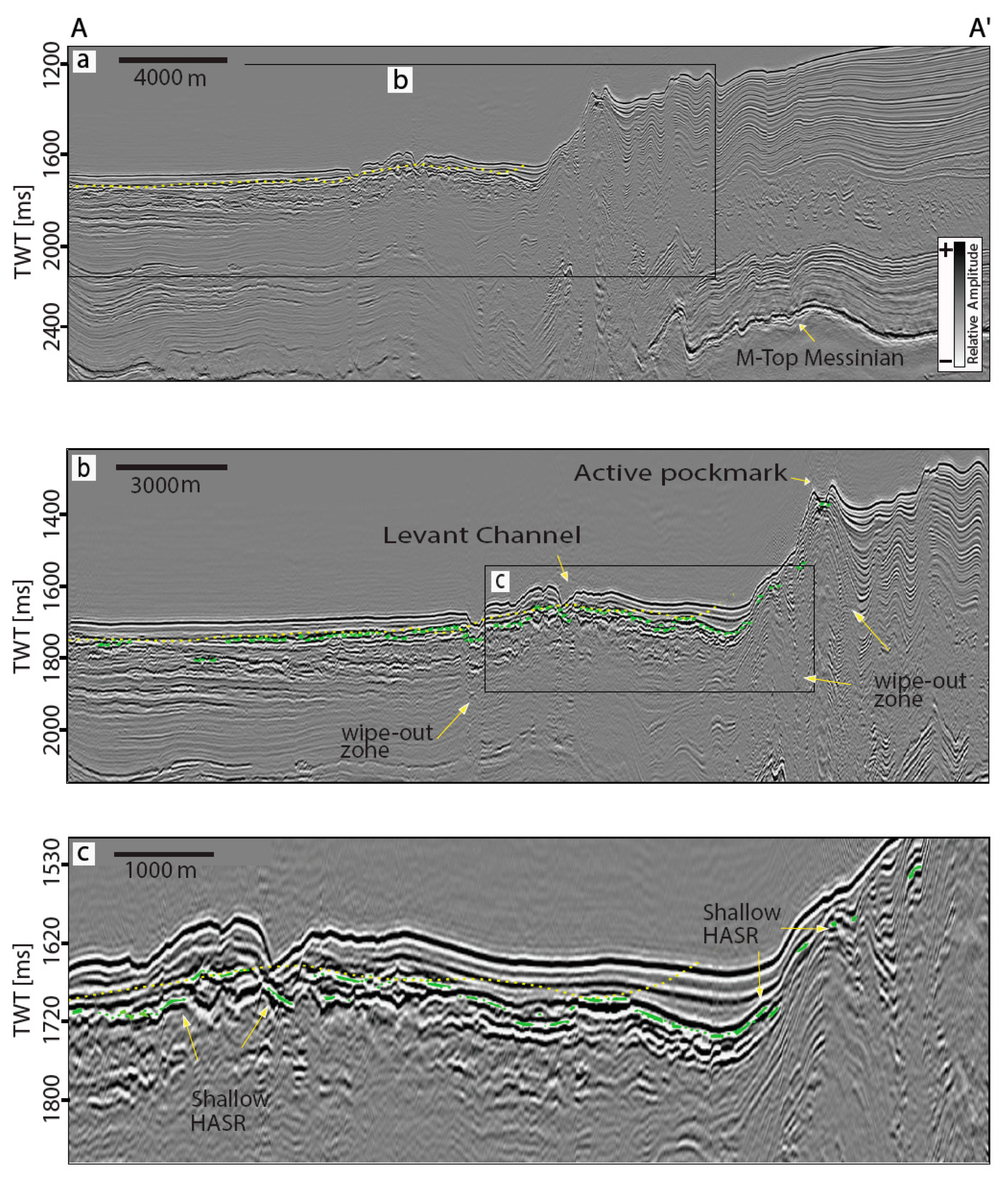
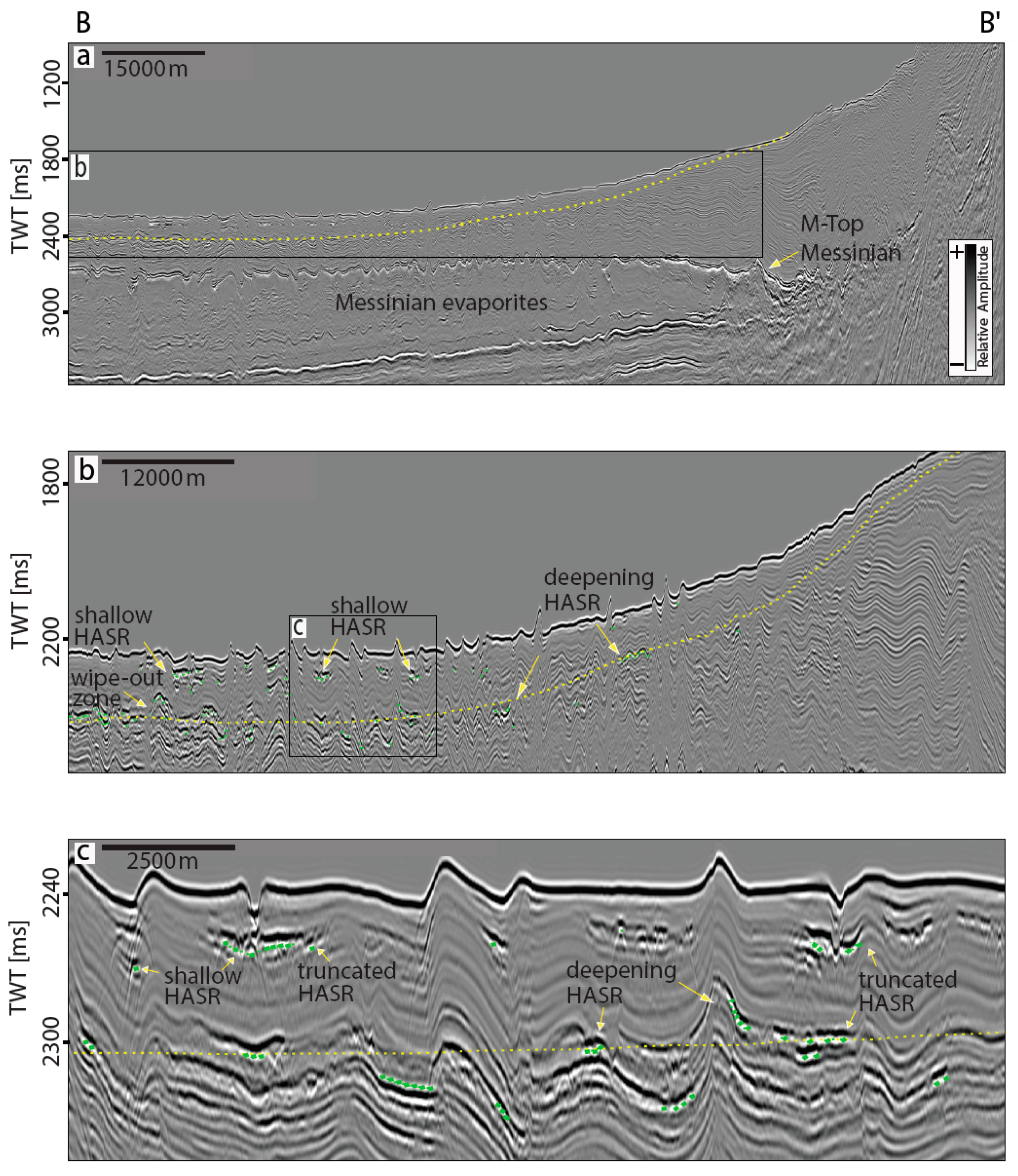
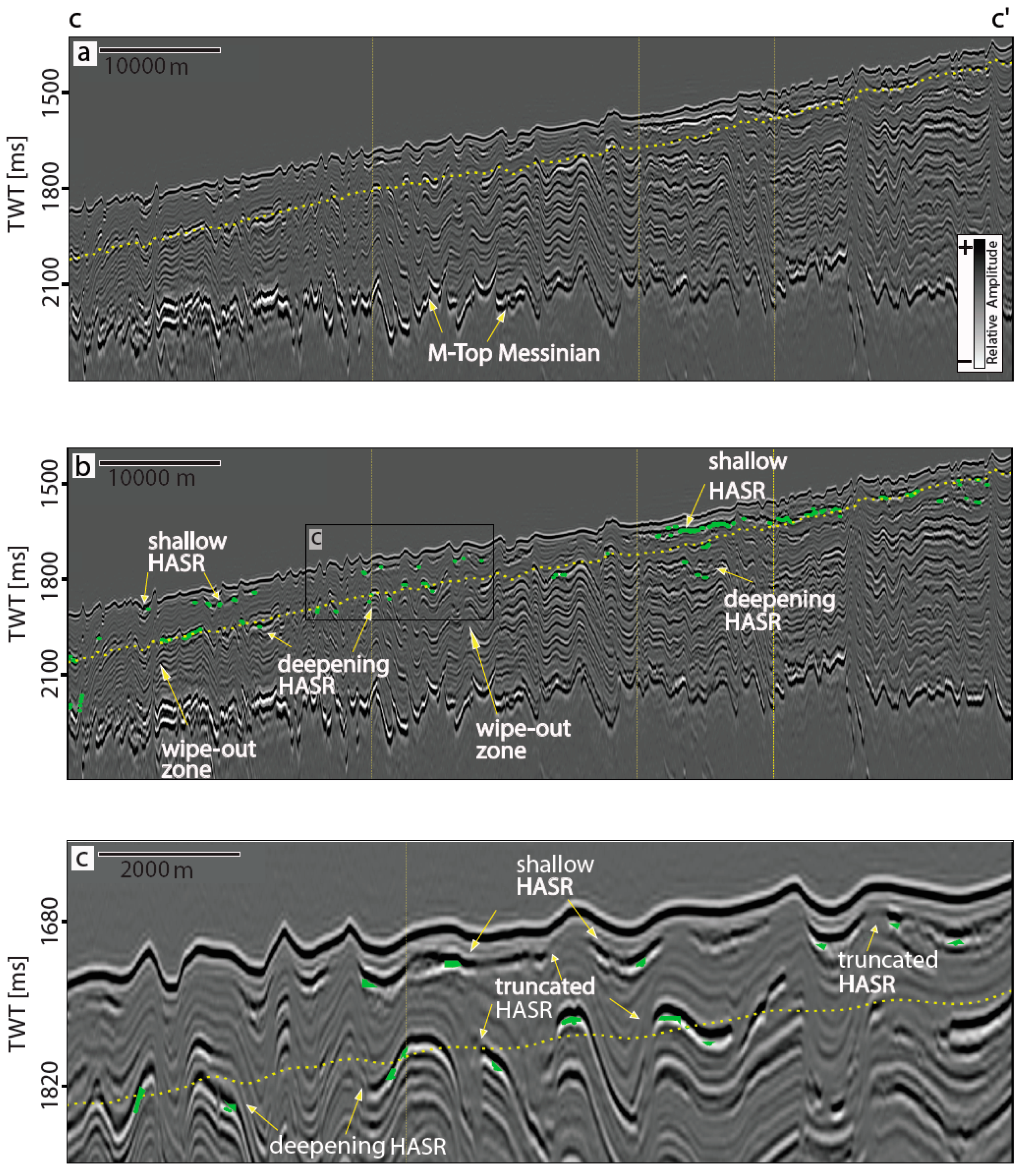
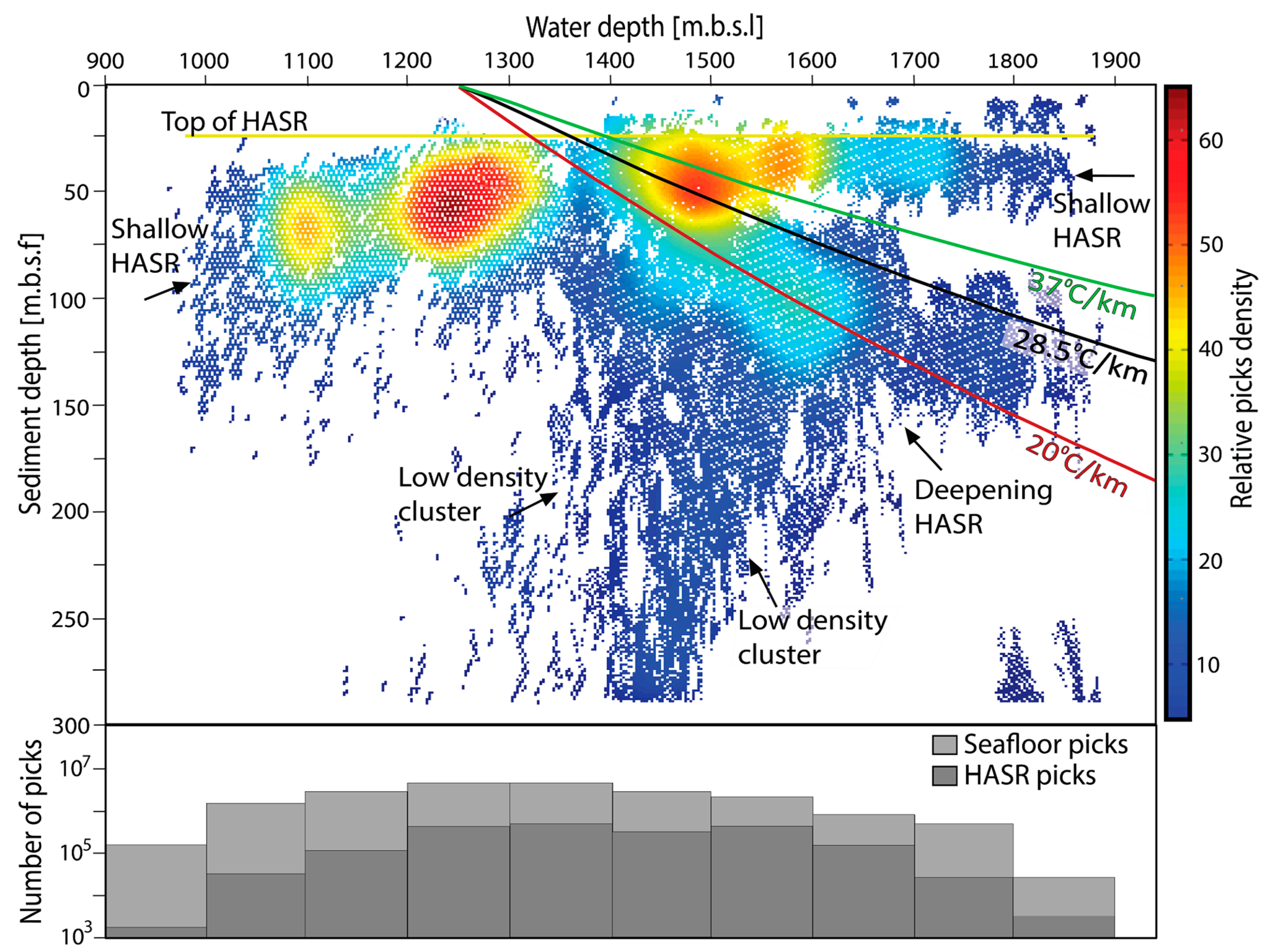
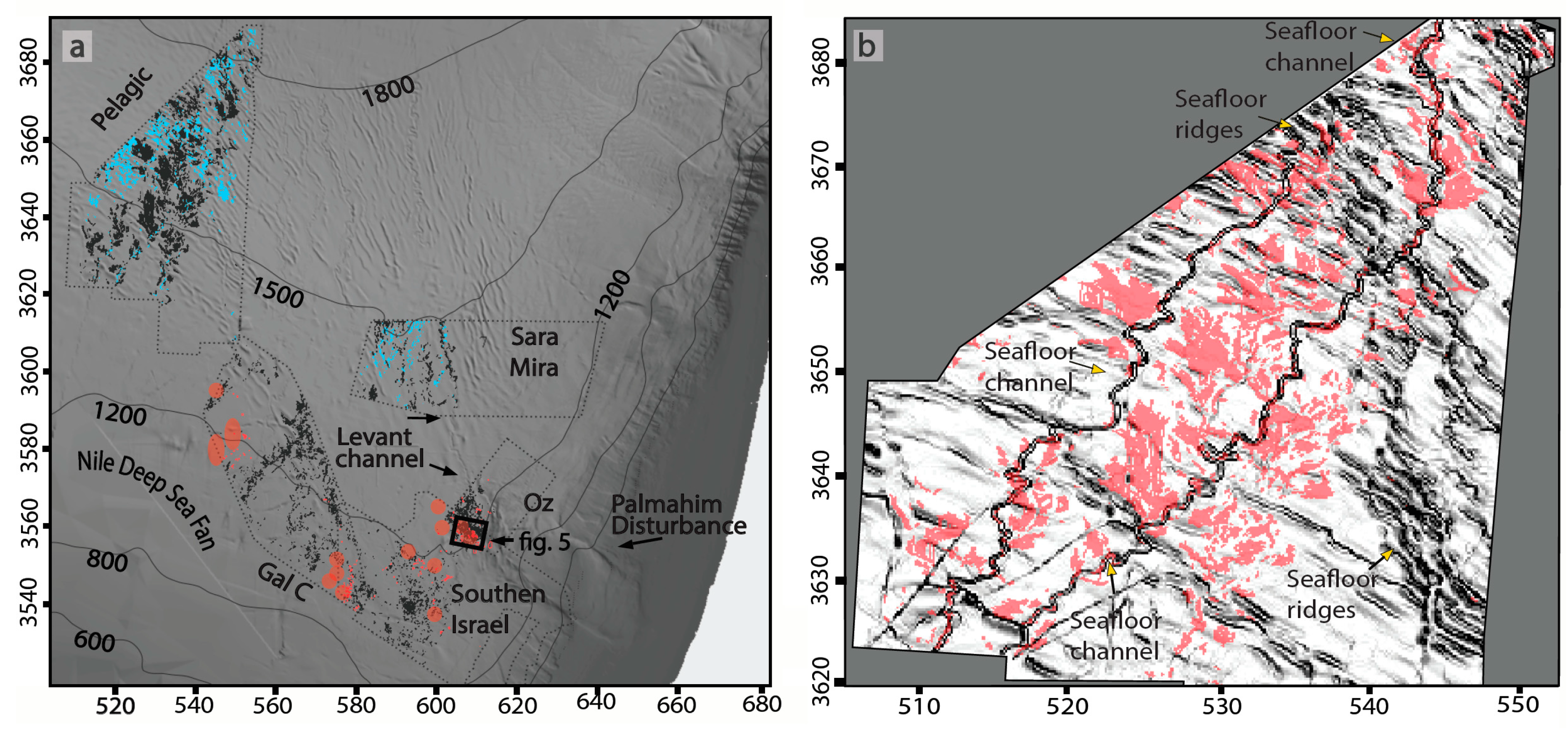
| Survey/Block | Type | Acquisition | Imaging | Area (km2) /Length (km) | Spacing (m) |
|---|---|---|---|---|---|
| Southern Israel | 3D | Gebco 2000 | Time Migration | 1900 | 12.5 × 12.5 |
| Gal-C | 3D | Gebco 2000 | Time Migration | 1400 | 12.5 × 12.5 |
| Oz | 3D | Ion-GTX | Depth Migration | 400 | 25 × 12.5 |
| Sara-Mira | 3D | CGG-Veritas 2011 | Depth Migration | 1350 | 25 × 12.5 |
| Pelagic | 3D | CGG-Veritas 2009 | Depth Migration | 2350 | 25 × 12.5 |
| TGS-IS209 | 2D | TGS-Nopec 2000 | Time Migration | 140 | 12.5 |
© 2019 by the authors. Licensee MDPI, Basel, Switzerland. This article is an open access article distributed under the terms and conditions of the Creative Commons Attribution (CC BY) license (http://creativecommons.org/licenses/by/4.0/).
Share and Cite
Tayber, Z.; Meilijson, A.; Ben-Avraham, Z.; Makovsky, Y. Methane Hydrate Stability and Potential Resource in the Levant Basin, Southeastern Mediterranean Sea. Geosciences 2019, 9, 306. https://doi.org/10.3390/geosciences9070306
Tayber Z, Meilijson A, Ben-Avraham Z, Makovsky Y. Methane Hydrate Stability and Potential Resource in the Levant Basin, Southeastern Mediterranean Sea. Geosciences. 2019; 9(7):306. https://doi.org/10.3390/geosciences9070306
Chicago/Turabian StyleTayber, Ziv, Aaron Meilijson, Zvi Ben-Avraham, and Yizhaq Makovsky. 2019. "Methane Hydrate Stability and Potential Resource in the Levant Basin, Southeastern Mediterranean Sea" Geosciences 9, no. 7: 306. https://doi.org/10.3390/geosciences9070306
APA StyleTayber, Z., Meilijson, A., Ben-Avraham, Z., & Makovsky, Y. (2019). Methane Hydrate Stability and Potential Resource in the Levant Basin, Southeastern Mediterranean Sea. Geosciences, 9(7), 306. https://doi.org/10.3390/geosciences9070306





